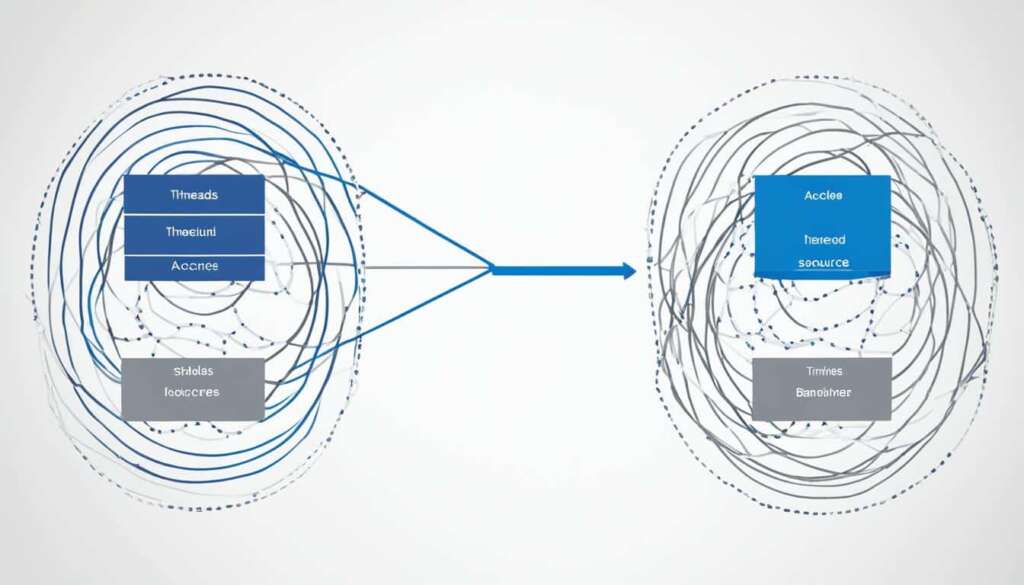Table of Contents
In computer programming, a mutual exclusion (mutex) is a program object that prevents multiple threads from accessing the same shared resource simultaneously. It is a mechanism used to ensure that only one thread can execute a critical section of code at a time. A mutex is applied to prevent race condition, a situation in which multiple threads try to access a shared resource at the same time. It is used to protect critical sections of code that update global variables, modify database tables, or write to network servers. A mutex ensures that threads access the critical section of code in a controlled and predictable manner.
In computer science, mutex plays a crucial role in managing concurrent processes and ensuring data integrity. By providing mutual exclusion, it allows threads to safely access shared resources, preventing conflicts and maintaining consistency in multithreaded programs.
In the next sections, we will further explore what a mutex object is, how it works in a multithreaded program, and its differences from a semaphore. Understanding mutex and its usage in computer science is essential for efficient and reliable concurrent programming.
What is a Mutex Object?
In a multithreaded program, a mutex object is utilized to control access to a critical section of code. This object ensures that multiple concurrent threads do not attempt to execute the critical section simultaneously, thus preventing race conditions. Race conditions can lead to incorrect data read/write, program misbehavior, or even crashes.
A mutex object can be requested for each shared resource from the underlying system. Threads can only access the resource if the mutex for that resource is unlocked. However, if the mutex is locked, the thread is usually queued until the mutex becomes unlocked.
It is important to note that different programming languages may have varying approaches to requesting a mutex lock. Let’s explore further examples and use cases to gain a better understanding of how mutex objects function in multithreaded programs.
Working of a Mutex in a Multithreaded Program
In a multithreaded program, a mutex ensures that threads execute their operations one at a time in the critical section of code. It prevents different threads from stepping over each other and returning undesired results. When a thread needs to access a shared resource, it first checks if the mutex for that resource is locked. If it is unlocked, the thread can execute the critical section. If it is locked, the thread is typically queued until the mutex becomes unlocked.
The exact implementation of requesting a mutex lock depends on the programming language used. For example, in Python, the threading module is used to acquire a lock for a shared resource.
By using a mutex lock, a multithreaded program can ensure that the critical section of code is executed atomically, eliminating race conditions and maintaining data integrity. This is particularly important when multiple threads are accessing and modifying the same shared resource.
In a multithreaded program, synchronization and resource management are crucial for the stability and correctness of the application. Mutex locks play a vital role in achieving this synchronization by allowing only one thread to access the critical section at a time. This ensures that the shared resource is accessed in a controlled and predictable manner, preventing data corruption and inconsistent results.
Furthermore, mutex locks reduce the occurrence of deadlocks, which can happen when two or more threads are waiting for each other to release resources, resulting in a deadlock state where none of the threads can progress.
Overall, understanding the working of a mutex in a multithreaded program is essential for writing efficient and reliable concurrent software.
Mutex vs Semaphore
When it comes to managing concurrent processes in operating systems, two common synchronization primitives are used: mutex and semaphore. Although both serve the purpose of synchronization, they have distinct functionalities in controlling access to shared resources.
A mutex, short for mutual exclusion, ensures that only one thread can access a critical section of code at a time. It acts as a binary lock, providing mutual exclusion by allowing exclusive access to the code. This prevents race conditions and ensures the integrity of shared resources. Mutexes are typically used when exclusive access to a resource is required.
On the other hand, a semaphore is a variable that enables multiple threads to access a shared resource simultaneously. Unlike a mutex, a semaphore can have multiple states and uses signaling mechanisms to control access. Semaphores are primarily used to allocate resources among multiple processes or threads, allowing controlled access to shared resources without blocking other threads.
While both mutex and semaphore play crucial roles in synchronization, their purposes and behaviors differ. A mutex guarantees exclusive access to a critical section, while a semaphore allows controlled concurrent access. Understanding the differences between these synchronization primitives is essential for effectively managing concurrent processes and ensuring the efficient use of shared resources.
FAQ
What is a mutex in computer science?
In computer programming, a mutex is a program object that prevents multiple threads from accessing the same shared resource simultaneously. It is used to ensure that only one thread can execute a critical section of code at a time.
What is a mutex object?
A mutex object is used in a multithreaded program to control access to a critical section of code. It ensures that multiple concurrent threads do not try to execute the critical section simultaneously.
How does a mutex work in a multithreaded program?
In a multithreaded program, a mutex ensures that threads execute their operations one at a time in the critical section of code. It prevents different threads from stepping over each other and returning undesired results.
What is the difference between a mutex and a semaphore?
While both a mutex and a semaphore are synchronization primitives used in operating systems to manage concurrent processes, they have different functionality. A mutex provides mutual exclusion to a critical section of code, allowing only one thread to access the code at a time. On the other hand, a semaphore allows multiple threads to access a shared resource simultaneously and can have multiple states.












